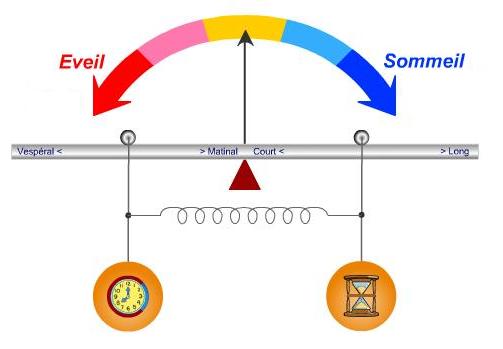Home > Welcome > Sleep-wake pathologies > Chronobiology - have to sleep > Chronobiology - Have to sleep
Chronobiology - Have to sleep
Francis Bacon (1561 - 1626), English philosopher.
Tuesday 7 August 2007
All the versions of this article: [English] [français]
Sleep is a vital need for almost all living beings...
The human species devotes 1/3 of its time to it.
It is a species that is genetically programmed to sleep at night.
The sleep/wake rythm is synchronized with the day/night cycle by a true clock located in the brain (but also in each of the nuclei of our cells). The sleep pressure it exerts depends of what time it is on the internal clock.
The conductor of that rythm is located in the brain. It realizes a daily setting through the intervention of external temporal signals like light and food.
The need for sleep responds to the laws of homeostasis (the ability to return to a state of balance).
The "sleep pressure" of that pendulum is proportional with the duration of the preceding wake and inversely.
The genetic and familial component of the individual characteristics of sleep is certain .
Sleep is a flexible and dynamic process which adapts daily to the needs of the organism.
The amount, the quality and the schedule of the occurrence of sleep are the three parameters that variate from day to day and from one person to another.
They depend on the life conditions (work, climate, meals) and of the individual characteristics of the sleeper.
These somnological characteristics define the "typology" of the sleeper.
The chronobiological balance of the subject depends on the adequation between his/her behavior and characteristics.
Follow this link to see the "C" clock and the "H" hourglass...
- Short or long sleep type ? (Horse or marmot ?)
- Evening or morning type ? (Owl or lark ?)
- Flexible or rigid (Cat or bird ?)
At normal state, there must be a harmony between the activity/sleep rythm and the day and night alternation.
That regulation obeys to a system that has been outlined in a mechanism with a double pendulum:
"The electric light screwed the whole thing up" (Pr Michel Jouvet)
Clic here to visualize the project of a pendulum animation.
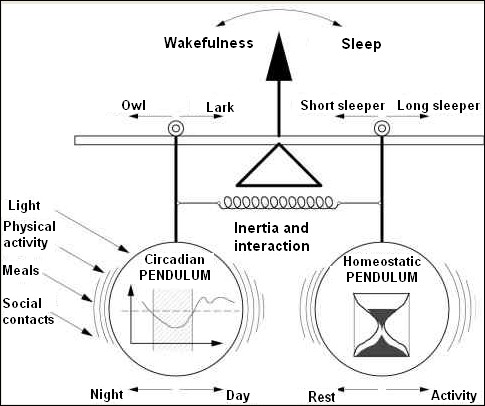
- Double pendulum model for the regulation of sleep/wake rythms
|
1. On the left side of the figure, the CIRCADIAN Pendulum [1] which behaves like a true internal clock that would open (and close again) the "gates of sleep" at some propitious moments of the "24 hours of the day" (the nyctemeron). The cyclic variation of the body temperature is its main marker. When separated experimentally from every external time signal, that clock remains set on 24 hours (See further in the article). It has been shown recently that there exists a code for an activity/rest cycle of 24h in the heart of the genome of each cell. The manipulation of these genes (called "Clock"), [2] produces cells that live according to another rythm (up to 28 hours). The animal lives that way, in a manner that is totally desynchronized from the Earth’s rotation. 3. External "time givers" (called Zeitgeber). : (light, heat, food and social contacts) intervene to synchronise sleep on the day/night alternation.
|
2. On the right side of the figure, the HOMEOSTATIC pendulum [3] can be compared with a simple hourglass that is turned upside down twice in 24 hours (after some time of accumulation of wakefulness or sleep). 4. The strength of the interactions between the two pendulums, and the inertia force of the whole system, determine the abilities to adapt to irregular sleep rythms.
|
1. «The homeostatic pendulum»
Can sleep duration be reduced ?
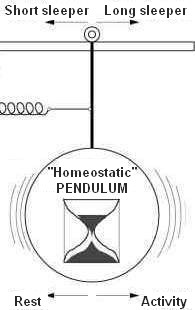
The experiments of sleep deprivation show the existence of an homeostatic regulation.
The return to balance expresses itself through an increase of sleepiness, proportional to the duration of the wake (the more one wakes, the stronger becomes the sleep pressure) on one hand and a rebound of efficiency of the compensatory sleep on the other hand.
That compensatory rebound expresses itself through a quantitative (duration) as well as a qualitative increase (of the percentage of slow waves and decrease of the transition phases of sleep).
It is thus possible to reduce sleep duration but that doesn’t mean that one can reduce his/her need for sleep.
Above all, it depends of the living conditions, but very outstanding individual factors explain the great variabilities that can be observed from one sleeper to the other.
The daily need for sleep (in average 8 hours) changes a lot between the individuals : 8hours in average, from 4 to 12 hours a day.
- A long period of wake imposes a long period of sleep and inversely.
- An important daily physical activity carries with it an increase of slow deep sleep (Cf. sleep and sport).
On the opposite, a lightening and an extension of sleep have been measured in sportsmen/women who are at rest after a wound, for example. (That particular case gives charts close to fibromyalgia.
In practice, it is possible to stand sleep deprivations (shift work, exceptional sleepless nights) if one is able to obey the rules of "predictive homeostasis" with, amongst others, the use of preventive or curative naps.
Some individuals will be physiologically more affected than others by that type of constraints.
Recent studies have shown, in animals, segments of chromosomes that are responsible for that characteristic (short/long sleeper). They thus confirm data issued from the observation in man.
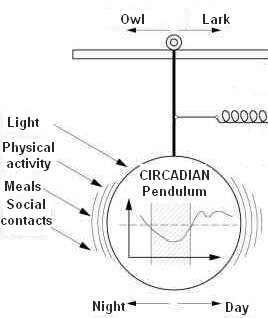
- The circadian pendulum, the clock of sleep
2. The "Circadian" pendulum
The level of alertness and the occurrence of sleep also depend of the influence of the "C" (circadian) pendulum.
The circadian pendulum can be seen like a true internal clock which synchronizes the periods of alertness and sleepiness on the day and night alternation, thanks to the clues of the external time givers (Cf.below).
The simulated car drive tests show the cyclic variation of alertness.
The risk for sleepiness increases perceptibly between 1 and 4 PM, and even more during the night, between 2 and 5 AM.
That fluctuation of the human rhythm appear in the statistics of the visites on a French website, where the periods of least arousal are easy to observe.

The circadian organization (in 24 hours) of sleepiness depends of the variations of the body temperature (which oscillates around 36.5°C with a minimum in the middle of the night and a maximum at the end of the day).
The cycle of the temperature is thus identical to that of alertness. It appears like one of the main determinants of the "gates of sleep". Therefore, the need for sleep in the evening matches a cooling down of the body. The same way, the well-known after lunch sleepiness ("postprandial") is not induced by the meal but matches a downturn of the curve of temperature around 3 PM.
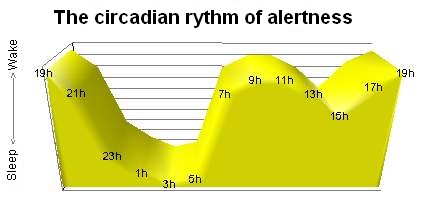
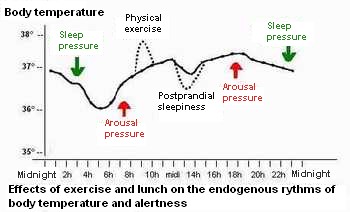
The multiple sleep latency tests (Cf. MSLT : sleep exploration) show that it is easier to fall asleep when the temperature decreases.
That circadian fluctuation of alertness is confirmed by electroencephalographic measurements ("alpha attenuation test"), or by the error rate in different cognitive and psychomotor tests.
On the opposite, the physical and intellectual performances are at their best around the thermic maximum which is located in the end of the afternoon.
That cyclic variation is partly due to the action of an hormone, which depends of darkness : melatonin, which behaves like a true internal clock.
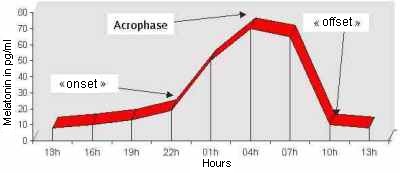
- The night signal given by melatonin
In the morning, the signal "day" is transmitted by the eyes to the brain (hypothalamus) which interrupts the noctural production of melatonin and programs the hour of the next evening secretion ("onset").
3. Time givers (called Zeitgeber [4]) :
Those are external factors with the power of influencing the circadian clock.
We know the most important four that act in synergy in order to synchronize the periods of sleep and wake with the day/night alternation.
The human species obeys, thus, to a strictly diurnal rhythm (nb : rats are indiscriminately diurnal or nocturnal because their circadian rythm obeys food supply which is, in that species, the main "time giver").
The rhythm of the circadian pendulum (measured on the cycle of the body temperature) depends on the action of a brain hormone : melatonin, secreted under the effect of enzymes of which the activity is commanded by the perception of light in the eyes.
Whether the subject is a morning or evening person, the curve of the body temperature and the peak of melatonin are slightly delayed or advanced compared to each other.
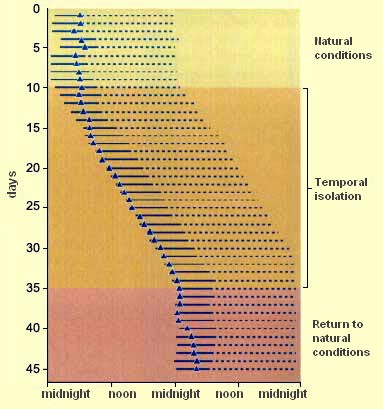
At the occasion of «out of time»experiments, all the subjects who were deprived of points of reference regarding time kept the same circadian rhythm. Without the action of the external synchronizers (Zeitgeber), the curve of the body temperature remains stable even though some subjects show a tendency to delay their sleep/wake rhythm.
A progressive shift of the sleep periods outside the thermic minimum phases appears in 30% of the tested individuals.
That desynchronisation expresses itself through a disturbance of the internal structure and duration of sleep, more or less well accepted according to the individual somnological characteristics. (Cf. Sleep plasticity test)
The recordings have been controlled during nine days under natural day conditions. Then, during 25 days, all the points of reference have been put off in order to let the person evolve towards his/her endogenous rythm. After several days of isolation, the sleep/wake cycle has a tendency to extend to reach 30 to 36 hours. The subject can, for example, stay awake during 20 hours, and then sleep for 12 hours and feel absolutely fine that way.
The four most important time givers :
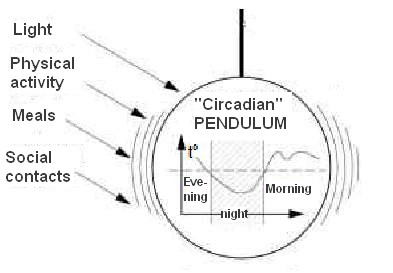
- Zeitgeber
- The light (and thus the rising hour) controls the melatonin secretion. It is proven that the exposure to light has an arousing effect and an influence on the sleep rhythms. «Phototherapy» has shown its efficiency in a large number of pathologies (insomnia, depression, fibromyalgia...).
- Physical exercice has a significant influence on the body temperature. The warmer the organism was during the day, the stronger becomes the action of melatonin on the fall of body temperature in the evening. Endurance sports (walking, jogging, swimming, ski...) are traditionally associated with a deeper sleep.(Cf.)
On the opposite, it is not advised to practice an intensive sport less than three hours before going to sleep.
Be careful, that advice for insomniacs must not lead the sick people to stop all activity too early in the evening, like some bad sleepers do who "wait for the train of sleep" from 9 PM on and hope to find sleep in trying not to do anything. - The meal hours influence the brain through hormones that have been discovered quite recently like the hypocretin/orexin (which has a common action in the food intake behaviors and the circuits of sleep).
- Social contacts, love, laughter and pleasure also play a role that is not to be neglected in the synchronization of the sleep rythms.
These new "somnications" are rarely the subject of specific scientific studies but some observations suggest their importance.
In 1532, Rabelais already asserted very opportunely that "The cheerful always recover"The pleasures of life are often associated with a short and efficient sleep whereas "clinophilia" (the need to lie down), in which the tired subjects seek shelter, prolonges the sleep duration but diminishes the slow wave activity, thus making the sensation of tiredness even worse. (Cf. "hypo-sleep syndrome)
Besides, it is known that (like in cases of forced bed rest), the sudden decrease of activity induces sleep disturbances and functional disorders very quickly. - Yawning is no "time giver" like the others, but it has two chronobiological effects;
- It might have an arousing effect through a direct stimulation of wake and an enhancement of brain oxygenation (but no recent study confirmed that)
- It has the effect of synchronizing the sleep rhythm with that of the other members of the group.
In higher primates (gorillas and humans), seeing someone yawn (even on a picture) is statistically enough to cause a yawn.
That particular feature, known for a long time (but is not to be seen in other species) is a legacy is from the period when mankind lived in hierarchical groups.
4. Inertia of the system and drive forces : To be taken into account for the understanding of the sleep regulation mechanisms. These parameters establish the flexibilty/rigidity typology of the sleeper.
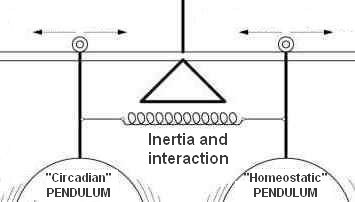
The ability to adapt to compulsory schedules changes a lot from one person to the other. It is less easy to measure than sleep duration (4 to 11 hours), but the studies show, in some individuals, (like, for example, the navigators) outstanding adaptative skills (these are genetically determined).
NB. Like for all biological functions, the system gains performance by a phenomenon of anticipation which requires a period of adaptation, which can sometimes be long whereas, on the contrary, decompensation occurs all of a sudden :
Insomnia doesn’t heal quickly, but only one evening in a disco is enough to delay one’s bedtime hour for several days. (That characteristic is similar to that of weight gain : "it is easier to put on weight than to lose weight").The respective weight of each of the pendulums is not equal, depending on the ground and the circumstances.
- The weight of the Circadian pendulum (the clock) depends on the somnological characteristics of the individual (which are genetically determined) and of the location in the nycthemeron (day/night biological cycle).
- The weight of the Homeostatic pendulum depends on the sleep pressure (in accordance to the preceding wake duration).
The risk of falling asleep can be at its highest if the two pendulums exert a cumulated effect, or at its lowest when they contrast.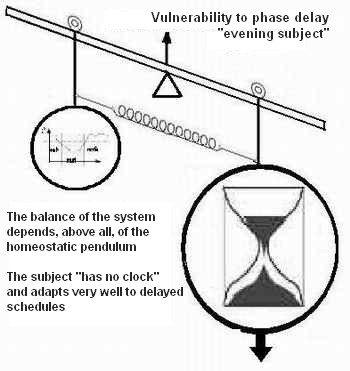 Here, the sleep/wake rhythm is under the dominant influence of the homeostatic pendulum.
Here, the sleep/wake rhythm is under the dominant influence of the homeostatic pendulum.
In case of an important sleep deprivation, the relative force of the "hourglass" is enough to allow sleep no matter the schedule.
That subject will be able to fall asleep quickly even in the morning, at the highest of the arousing thermic ascent (due to the action of the "C" pendulum).
Some sleeptypes thus accept nightwork very easily provided they know how to manage their rest periods.
That profile sometimes leads to a phase delay with insomnia in the evenings and sleepiness in the mornings.
Evening people are penalized by too early morning schedules.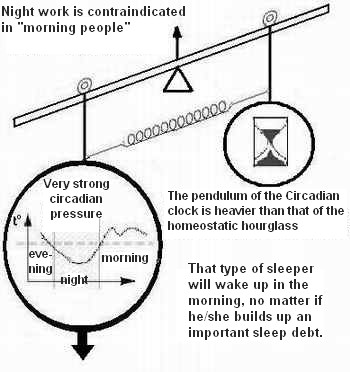 Here, the Circadian Clock has the authority of a true automatic "alarm clock".
Here, the Circadian Clock has the authority of a true automatic "alarm clock".
That subject wakes up early even after a very short night, and will be able to work very early under the condition of being able to pay his/her sleepdebt by having an occasional nap".
These individuals are very sensitive to the «clock» and are unable to sleep correctly if they go to bed in the morning (it becomes possible only if sleep pressure is very strong but the subject complains of an unrestful sleep).
There exist, thus, true contraindications regarding nightwork !.The breaking of the balance expresses itself in a chaotic movement (mathematically unpredictable :)
The human ability to resist an upset life rhythm is considerable but not unlimited.
The balance of the sleep/wake regulation is equivalent to a double pendulum mechanism. Its destabilization causes a random chaotic movement.
Experimentally, that unbalance shows through a chart rich of functional symptomatology.In sleep medicine, that chart is described as a "syndrome of internal desynchronization" or "jet lag" (Cf), which causes tiredness and sleep disorders until the circadian rhythms are again in harmony with the external synchronizers.
The breaking of the balance can express itself in two modes, combined or not :
- quantitative lack of sleep causes sleepiness
- qualitative lack of sleep causes tiredness
Experimental sleep fragmentation also induces a polymorph clinical chart of a tiredness and pain kind, similar to fibromyalgia and to chronic fatigue syndrome and which are caused, in our opinion, by the same physiopathological mechanism.
Its translation in general medicine is the "hypo-sleep syndrome" which we introduce in the section "hypo-sleep and general medicine".Conclusion
- The spreading of the sleep hygiene rules has become a priority to the Authorities because a better knowledge of the sleep rhythms could be one of the stakes of man’s adaptation to modern times.
- Taking the individual characteristics and physiological rythms of the individuals into account is more and more necessary in order to maintain performances since the "invention of electric light which screwed the whole thing up" (Pr Jouvet).
It could contribute to understand better and prevent problems as manifold as stress at work and accidentological statistics.
The nap is the keystone of the problems of sleepiness caused by a quantitative lack of sleep but must not contribute to delay the diagnosis of an excessive sleepiness (like in a sleep apnea syndrome). - A better understanding of the mechanisms that control the schedules and the quality of sleep is, besides, essential for the care of insomnia and its corollary, tiredness, which most often ensue from true cognitive and behavioral vicious circles.

- More information...
- National Center of Sleep Disorders Research
- Star sleeper, I need your help "Garfield and the National Center on Sleep Disorders Research have teamed up to bring you information on sleep and how it helps kids do their best at whatever they do".
- Watch an exciting conference by Pr. Jouvet, the undisputed father of sleep research in France) on the website of the UTLS, 04/02/2000 University of all knowledges
- Cellular chronobiology and the gene "ClocK" (Brain at McGill).
- A beautiful modelization of a chaotic movement by G Tulloue, physicist (Exciting and very funny).
[1] CIRCADIAN: from "circa dies", litterally "about a day (and a night)"; describes a rythm that occurs with a period of more or less 24 hours. They are to be distinguished from the ultradian rythms (ultra : «beyond», more than, 24 hours) and the infradian (infra : «short of», less than 20 hours).
Back to text
[2] "In 1997, Joseph Takahashi and his team identify in mice a gene which, mutated, extends the circadian period from 24 to 28 hours in constant conditions of light or darkness. After several weeks in these conditions, some of the mutant mice even loose all sort of periodicity in their behavior. Takahashi, not without a sense of humour, calls that gene "Clock", for « Circadian Locomotor Output Cycles Kaput »
Back to text
[3] HOMEOSTASIS : Tendency of the organism to maintain or bring back the different physiological constants (temperature, blood flow, blood pressure, etc.) to degrees that do not deviate from the norm.
"The equilibriums in the organism are not, in general, static, but homeostatic ; they maintain themselves in spite of changing external conditions" (RUYER, Cybern., 1954, p. 55).
Back to text
[4] Time giver is the litteral translation of Zeitgeber. The term was introduced into science about 1954 by Jürgen Aschoff, a German Biologist, 1913 - 1998
